Transparent artificial muscle to enable camouflaging in soft robots
15. 7. 2020 | Tech Xplore | www.techxplore.com
The ability to become transparent is a considerable evolutionary advantage, as it allows animals to blend in with their environment, avoid predators and mask their movements. Robots with similar capabilities could be of great value for a number of applications, for instance, aiding surveillance and research that involves observing animals in their natural habitat.
Researchers at National University of Singapore have recently fabricated a transparent artificial muscle that could be used to build bio-inspired robots capable of camouflaging themselves. This unique structure, introduced in a paper presented at the 2019 IEEE International Conference on Robotics and Biomimetics (ROBIO), are based on dielectric elastomer actuators (DEAs), a class of electroactive polymers commonly used to fabricate soft robots, artificial muscles and flexible devices.

Despite their advantageous properties, such as their flexibility and electrical conductivity, conventional DEAs are unable to mimic the transparent appearance acquired by animals with camouflaging capabilities. In fact, most of these polymers are made of viscous dark materials, such as carbon grease, which cannot become transparent. The researchers at National University of Singapore, on the other hand, built their artificial muscle using DEAs that incorporate a blend of clearer materials.
Read more at Tech Xplore
Image Credit: National University of Singapore
-jk-




